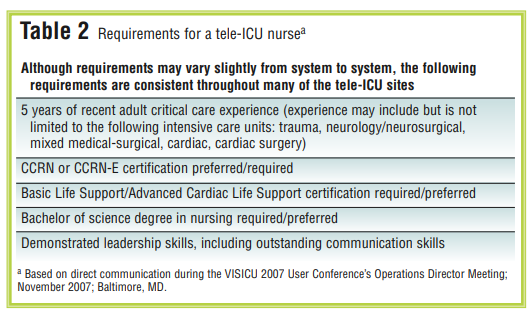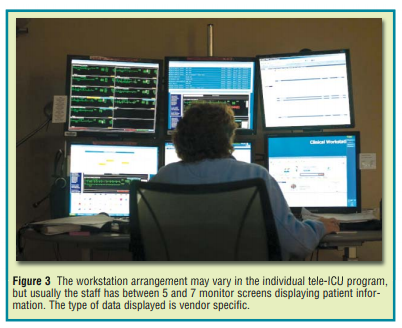Part
01
of one
Part
01
Tele-ICUs - Organizational Structure (2)
Tele-ICU clinical models are divided into two main models, namely centralized continuous care model and decentralized care model. Irrespective of the model, a typical tele-ICU comprises a medical director, ePhysicians, registered nurses (eRNs), and support staff members that include clinical support staff and IT professionals. The roles and functions, skills required, and average hourly wage-rates of these team members are presented below. In absence of any industry literature around the typical average salaries of tele-ICU team members in the US, the research team has considered the average salaries of telemedicine professionals like medical director, physicians, registered nurses, and support staff members on recruitment websites like Indeed and Salary as suitable proxies.
Types of Tele-ICU Clinical Models
- There are mainly two tele-ICU clinical models, namely centralized continuous care model and decentralized care model. These models depend upon factors like the number of patients that require tele-ICU services at a time, existing bedside resources in terms of both technology and human care, patient acuity, and contractual arrangements.
- In the centralized continuous care model, the patients are monitored for a certain time period without any interruption, say for 8 hours, 16 hours, or 24 hours.
- The decentralized care model consists of two sub-models, namely the scheduled care model and the responsive (reactive) care model.
- In the scheduled care model, the tele-ICU registered nurses (eRNs) or the tele-ICU physicians (ePhysicians) make periodic consultations with the patients based on a predetermined schedule, such as during patient rounds.
- In the responsive (reactive) care model, the tele-ICU registered nurses (eRNs) or the tele-ICU physicians make unscheduled virtual visits to meet the patients. These visits are prompted by alerts, such as a monitor alarm, telephone call, or page.
Overview of a Typical Tele-ICU Model
- Even though the technology and structure is relatively consistent within the above tele-ICU models, "program staffing models vary according to the needs of the hospitals within the system and the availability of resources."
- A typical tele-ICU is operational for 24 hours a day and 7 days in a week. It "is staffed with critical care nurses and support staff with the intensivist on site 15 to 20 hours a day."
- In some tele-ICU "programs, the intensivist works only the off-shift hours when on-site physicians have signed out to the on-call system."
- Some tele-ICU programs have even contemplated replacing "tele-ICU registered nurses (eRNs) by midlevels such as nurse practitioners or physician assistants."
- Whatever the model, a typical tele-ICU structure has 1 tele-intensivist for every 60 to 125 patients, 1 eRN for every 30 to 40 patients, and 1 clerical assistant for every 50 to 125 patients.
Team Members Within a Typical Tele-ICU Model
Tele-ICU Medical Director
- The tele-ICU medical director oversees the operations of the tele-ICU, including the quality of medical care being provided to the patients, teamwork and collaboration among the tele-ICU staff, and coordination between the tele-ICU team members and the ICU.
- It is essential for the tele-ICU medical director to "demonstrate strong leadership skills in order to build and strengthen the working relationships if the transformation of care is to be accomplished."
- According to the recruitment website 'Salary,' the hourly wage rate of a typical tele-ICU medical director in the US is between $127 and $152, while the average is $139. The hourly rate varies depending on education, skill, certifications, experience, and responsibilities.
Tele-ICU Physician (ePhysician) or Tele-intensivist
- "Tele-ICU physicians (ePhysicians) are board-certified/board-eligible intensivists, privileged and credentialed in each participating hospital, who provide oversight and intervention as appropriate for patient safety or as requested by the attending physician."
- Even though some tele-ICU programs have full-time ePhysicians, most programs have physicians on rotational basis.
- ePhysicians provide a variety of services like multidisciplinary assessment of the patients via camera over several rounds, coordinating with the eRN or ePhysician from the previous shift, discussing any changes to the patient care plan with the bedside team, analyzing the patient's health status through test reports and other patient data, "discussing weaning options with respiratory therapists, identifying potential patients for transfer, or entering the orders for bundle compliance."
- After assessing the patients every 1 to 4 hours based on the patient acuity or changing needs, the ePhysicians may also directly coordinate with the IT support staff and enter the "orders into the system software, or if available, directly into the hospital’s order entry system."
- According to the recruitment website 'Indeed,' the average salary for a tele-ICU physician in the US is $98.28 per hour. However, this varies according to specialization, location, and experience. According to a report by Philips, the average annual salary of a tele-intensivist in the US is $306,000.
Tele-ICU Registered Nurse (eRN)
- The role of tele-ICU registered nurses (eRNs) is to monitor ICU patients for 24 hours a day and 7 days in a week and then coordinate with the ePhysicians regarding the treatment of the patients.
- Similar to the ePhysician staffing mechanism within tele-ICU models, "the eRN models vary among programs. Some tele-ICUs may employ only dedicated eRNs, whereas others contain a combination of dedicated and 'shared' positions. The staff with shared positions have a secondary position in the tele-ICU and a primary position in the ICU; dedicated eRNs work only in the" tele-ICUs.
- The advantages of the shared position model are increased collaboration among the tele-ICU and the ICU and continued clinical competence of the eRNs. The disadvantages of this model are increased dependence on the staff, performance evaluations at both places, increased communication among reporting managers of both the tele-ICU and the ICU, and haphazard scheduling and job rotation.
- "In programs with only dedicated positions, eRNs work full time in the tele-ICU. This simplifies scheduling, evaluation, and identity issues and contributes to team stability and staff satisfaction. However, ICU staff often voice concerns about the eRN’s ability to maintain clinical competence when not providing care at the bedside."
- The minimum educational and professional requirements for a tele-ICU registered nurse are highlighted in the following table.
- The most important skill required for the eRN position is excellence in communication. "Computer and workflow skills can be obtained through orientation and experience, but poor communication and customer service skills are counterproductive and deleterious to the goals of the program."
- According to the recruitment website 'Salary,' the hourly wage rate of a tele-ICU registered nurse in the US is between $41 and $48, while the average is $44. The hourly rate varies depending on education, skill, certifications, and experience.
Support Staff Members
- Support staff members include professionals responsible for phone management, video monitoring, quality monitoring, and data entry, among others. These include clinical support staff and IT professionals. "Support staff may have a variety of backgrounds, including previous experience as a unit secretary, nursing assistant, or as a nursing student seeking part-time employment."
- Similar to the skills required for an eRN, support staff members should be committed to excellence in the field of customer service. They should also "be competent in the management of various computer software systems and demonstrate accuracy in data entry as the data may be used to support clinical decision-making."
- Coordination between the clinical support staff and the IT support staff is essential for the success of a tele-ICU program. "The ability of the clinical staff to articulate their needs to the information services team in a way that promotes shared understanding takes time and energy but is vital to the success of technology integration" within the boundaries of the tele-ICU program.
- While there are different classification and types of support service jobs in a tele-ICU environment, a common average salary for the entire category is not available in the public domain. However, the average salary is lower than that of a tele-ICU registered nurse. According to the recruitment website 'Salary,' the hourly wage-rate of a tele-ICU call center nurse in the US is between $34 and $42, while the average is $37. The hourly wage-rate of a tele-ICU quality assurance analyst in the US is between $29 and $39, while the average is $34.

